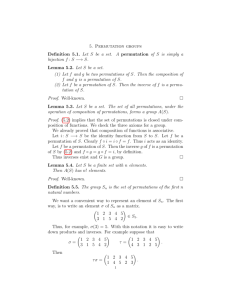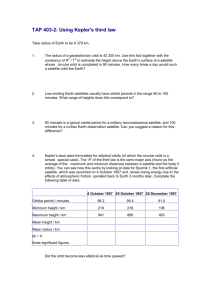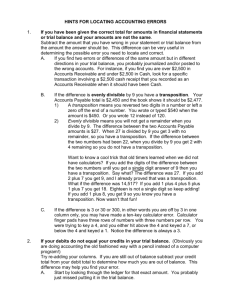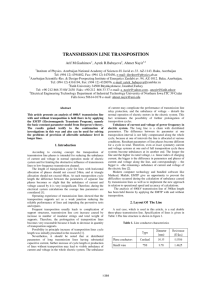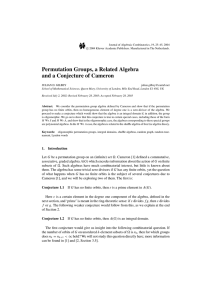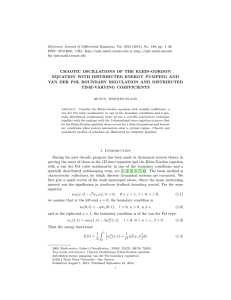MATH 3020 A: Homework 5 Solution Ideas
advertisement
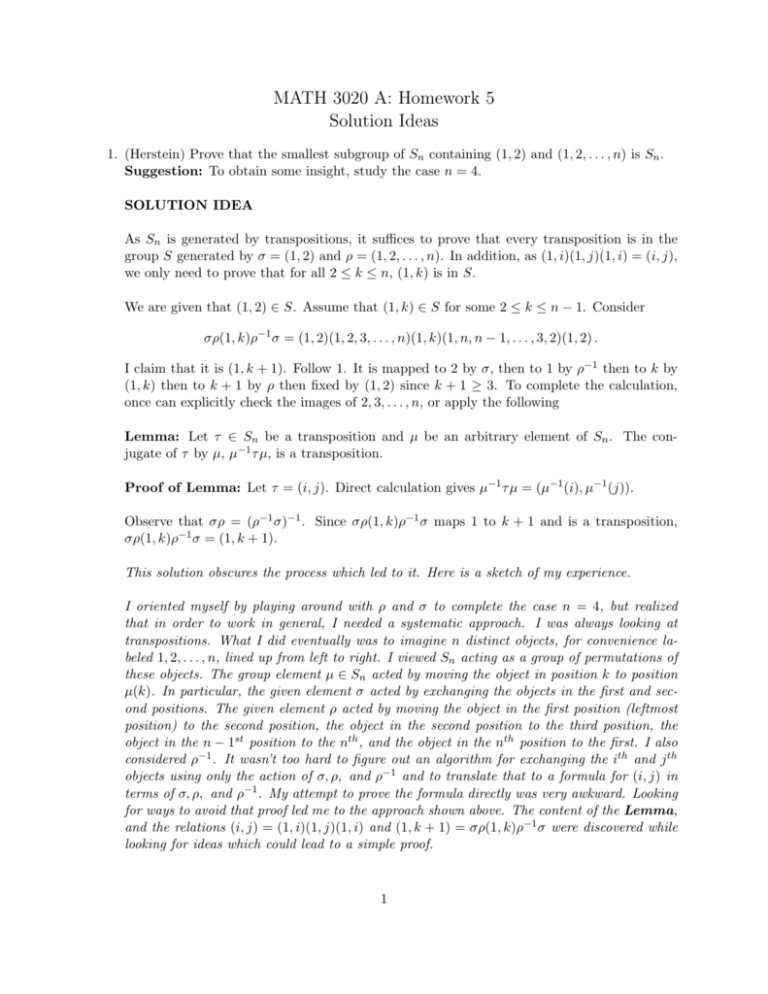
MATH 3020 A: Homework 5
Solution Ideas
1. (Herstein) Prove that the smallest subgroup of Sn containing (1, 2) and (1, 2, . . . , n) is Sn .
Suggestion: To obtain some insight, study the case n = 4.
SOLUTION IDEA
As Sn is generated by transpositions, it suffices to prove that every transposition is in the
group S generated by σ = (1, 2) and ρ = (1, 2, . . . , n). In addition, as (1, i)(1, j)(1, i) = (i, j),
we only need to prove that for all 2 ≤ k ≤ n, (1, k) is in S.
We are given that (1, 2) ∈ S. Assume that (1, k) ∈ S for some 2 ≤ k ≤ n − 1. Consider
σρ(1, k)ρ−1 σ = (1, 2)(1, 2, 3, . . . , n)(1, k)(1, n, n − 1, . . . , 3, 2)(1, 2) .
I claim that it is (1, k + 1). Follow 1. It is mapped to 2 by σ, then to 1 by ρ−1 then to k by
(1, k) then to k + 1 by ρ then fixed by (1, 2) since k + 1 ≥ 3. To complete the calculation,
once can explicitly check the images of 2, 3, . . . , n, or apply the following
Lemma: Let τ ∈ Sn be a transposition and µ be an arbitrary element of Sn . The conjugate of τ by µ, µ−1 τ µ, is a transposition.
Proof of Lemma: Let τ = (i, j). Direct calculation gives µ−1 τ µ = (µ−1 (i), µ−1 (j)).
Observe that σρ = (ρ−1 σ)−1 . Since σρ(1, k)ρ−1 σ maps 1 to k + 1 and is a transposition,
σρ(1, k)ρ−1 σ = (1, k + 1).
This solution obscures the process which led to it. Here is a sketch of my experience.
I oriented myself by playing around with ρ and σ to complete the case n = 4, but realized
that in order to work in general, I needed a systematic approach. I was always looking at
transpositions. What I did eventually was to imagine n distinct objects, for convenience labeled 1, 2, . . . , n, lined up from left to right. I viewed Sn acting as a group of permutations of
these objects. The group element µ ∈ Sn acted by moving the object in position k to position
µ(k). In particular, the given element σ acted by exchanging the objects in the first and second positions. The given element ρ acted by moving the object in the first position (leftmost
position) to the second position, the object in the second position to the third position, the
object in the n − 1st position to the nth , and the object in the nth position to the first. I also
considered ρ−1 . It wasn’t too hard to figure out an algorithm for exchanging the ith and j th
objects using only the action of σ, ρ, and ρ−1 and to translate that to a formula for (i, j) in
terms of σ, ρ, and ρ−1 . My attempt to prove the formula directly was very awkward. Looking
for ways to avoid that proof led me to the approach shown above. The content of the Lemma,
and the relations (i, j) = (1, i)(1, j)(1, i) and (1, k + 1) = σρ(1, k)ρ−1 σ were discovered while
looking for ideas which could lead to a simple proof.
1
2. (Lang, Algebra) Let σ be a permutation of the finite set I = {1, 2, . . . , n}. Define the sign of
σ, written (σ), to be (−1)m where
m = n − number of orbits of σ .
(a) If I1 , . . . , Ir are the orbits of σ, prove that m is also equal to the sum
m=
r
X
[card(Iν ) − 1] .
ν=1
(b) Recall that a permuation τ of I is called a transposition if there exist two elements i 6= j
in I such that τ (i) = j, τ (j) = i, and τ (x) = x for x ∈ I, x 6= i, j.
If τ is a transposition, show that (στ ) = −(σ) by considering two cases, when i, j
lie in the same orbit of σ, or lie in different orbits. In the first case, show στ has one
more orbit and in the second case show it has one fewer orbit than σ.
(c) Use the previous to show that the sign of a transposition is −1.
(d) Recall that the transpositions generate Sn , the group of permutations of I. Use Mathematical Induction to prove that if σ = τ1 . . . τm where the τi are transpositions, then,
(σ) = (−1)m and that if σ, σ 0 are two permutations, then (σσ 0 ) = (σ)(σ 0 ).
SOLUTION IDEA
(a) The index r is just the number of orbits of σ.
r
X
[card(Iν ) − 1] =
ν=1
r
X
ν=1
card(Iν ) −
r
X
1 = n−r.
ν=1
(b) We are comparing the number of orbits of στ with those of σ. Represent σ as a product
of r disjoint cycles, each of which is an orbit of σ. If i and j are both in the same
orbit of σ, say σ has cycle (i, a1 , a2 , . . . , ak , j, ak + 1, . . . , al ) in its disjoint cycle decomposition, then (i, a1 , a2 , . . . , ak , j, ak+1 , . . . , al )(i, j) = (i, ak+1 , . . . , al )(j, a1 , . . . , ak ) and as
the other orbits of στ are identical to those of σ, στ has one more orbit than σ. If i and
j are in different orbits, say, (i, a1 , . . . , ak ) and (j, b1 , . . . , bl ) appear in the disjoint cycle
decomposition of σ, then (i, a1 , . . . , ak )(j, b1 , . . . , bl )(i, j) = (i, b1 , . . . , bl , j, a1 , . . . , ar ) and
στ has one fewer orbit than σ.
(c) Let ι be the identity permutation. As ι has n orbits, (ι) = (−1)0 = 1. Then (τ ) =
(ιτ ) = −(ι) = −1.
(d) Without formalizing as a proof by Mathematical Induction, we have, (τ1 · · · τm ) =
(−1)(τ1 · · · τm−1 ) = (−1)2 (τ1 · · · τm−2 ) = · · · = (−1)m−1 (τ1 ) = (−1)m .
Write σ 0 = τ1 · · · τm . Then (σ 0 ) = (−1)m . As in the previous, (σσ 0 ) = (στ1 · · · τm ) =
(στ1 · · · τm−1 )(−1) = (στ1 · · · τm−2 )(−1)2 = · · · = (στ1 )(−1)m−1 = (σ)(−1)m =
(σ)(σ 0 ).
2
3. (Lang, Herstein) Let I = {1, 2, · · · , n} as above. Prove that for any permutation σ,
Y
Y
(j − i) .
[σ(j) − σ(i)] = (σ)
1≤i<j≤n
1≤i<j≤n
Comment: In Anton, Rorres, Linear Algebra, the sign (σ) of a permutation
1
2
···
n
σ=
σ(1) σ(2) · · · σ(n)
is determined by counting the number of times a larger number preceeds a smaller one in
the list σ(1), σ(2), . . . , σ(n). If that number is even, then (σ) = 1. If it is odd, then (σ) = −1.
SOLUTION IDEA
First consider the case when σ = τ is a transposition, say τ = (k, l) with k < l. Under
the action of τ , the list
1, 2, . . . , k−1, k, k+1, . . . , l−1, l, l+1, ..., n becomes 1, 2, . . . , k−1, l, k+1, . . . , l−1, k, l+1, ..., n .
The
Yproducts are taken over all pairs on these lists,“right” minus“left”. Which terms in
(j − i) change sign when k and l are interchanged? Those of the form (l − j) for
1≤i<j≤n
k + 1 ≤ j ≤ l − 1 become (j − l). Those of the form (j − k) for k + 1 ≤ j ≤ l − 1 become
(k − j). Finally (l − k) becomes (k − l). This is an odd number of changes and there are no
others.
The same comparison gives
Y
[στ (j) − στ (i)] = (−1)
1≤i<j≤n
Y
[σ(j) − σ(i)] .
1≤i<j≤n
Observe that for τ = (k, l), k < l, sign changes occur in these products twice for each j such
that k + 1 ≤ j ≤ l − 1, and once more when (σ(l) − σ(k)) changes to (σ(k) − σ(l)).
The proof is completed using the same form of argument as in 2.(d).
3
